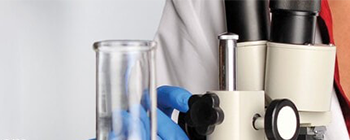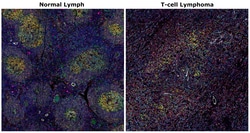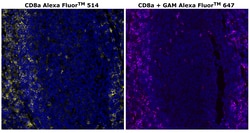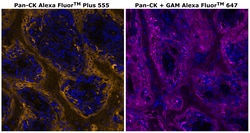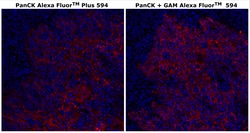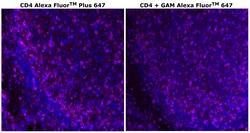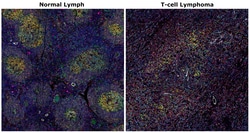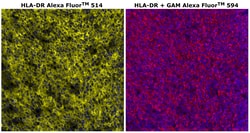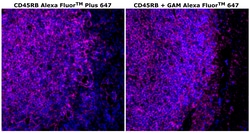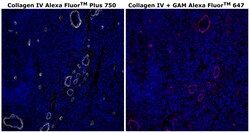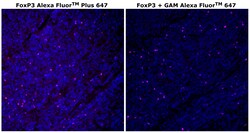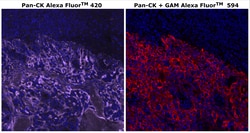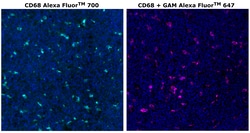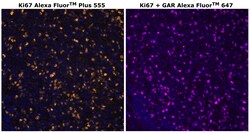
Antibodies
Antibodies are glycoproteins that serve an essential role in the immune system to protects animals from infection, or the cytotoxic effects of foreign compounds, by binding with high affinity to invasive molecules; classified as primary or secondary.

Primary Antibodies
(131,885)

Secondary Antibodies
(2,371)

Isotype Controls and Standards
(623)

Antibody Panels and Kits
(60)
1
–
15
de
126,219
résultats
| Applications | Immunocytochemistry,Western Blot |
|---|---|
| Type de produit | Antibody |
| Isotype | IgG |
| Conjugué | Unconjugated |
| Espèces cibles | Human |
| Concentration | 0.5 mg/mL |
| Primaire ou secondaire | Primary |
| Forme | Liquid |
| Contenu et stockage | Store at 4°C short term. For long term storage, store at -20°C, avoiding freeze/thaw cycles. |
| État réglementaire | RUO |
| Numéro d’ordre du gène | P68431, Q71DI3 |
| Immunogène | Peptide corresponding to Human HIST1H3A (aa 24-31). |
| Expression | H3C15 |
| Classification | Polyclonal |
| Identification génétique (Entrez) | 126961, 333932, 8350, 8356, 8357, 8358, 8968 |
| Méthode de purification | Affinity Chromatography |
| Espèces hôtes | Rabbit |
| Symboles de gène(s) | H3C1, H3C10, H3C12, H3C14, H3C15, H3C2, H3C7 |
| Formule | PBS with 0.1% BSA, 30% glycerol and 0.09% sodium azide; pH 7.2 |
| Alias de gène | dimethyl H3; di-methyl H3; Dimethyl Histone H3; di-methyl histone H3; Di-Methyl-H3 K27; Di-Methyl-H3 Lys27; Di-Methyl-Histone H3 K27; Di-Methyl-Histone H3 Lys27; Di-Tri-Methyl-Histone H3 K27; Di-Tri-Methyl-Histone H3 Lys27; H3; H3 histone; H3 histone family, member A; H3 histone family, member I; H3 histone family, member K; H3 histone family, member L; H3 histone family, member M; H3 histone, family 2; H3 histone, family 3A; H3 histone, family 3B; H3 histone, family 3B (H3.3B); H3 histone, family 3B.1; H3 histone, family 3C; H3 K27me2; H3.1-221; H3.1-291; H3.1-I; H3.2; H3.2-221; H3.2-614; H3.2-615; H3.2-616; H3.3A; H3.3B; H3.5; H3/A; H3/b; H3/d; H3/f; H3/i; H3/j; H3/k; H3/l; H3/M; H3/n; H3/o; H3-143; H3-291; H3-3A; H3-3B; h3-5; H3-53; H3-614; H3a; H3b; H3-B; H3C1; H3c10; H3c11; H3C12; H3C2; H3C3; H3C4; H3C6; H3C7; H3C8; H3f; H3-F; H3F1K; H3F2; H3F3; h3f3a; H3F3B; h3f3b.1; h3f3c; h3f3d; H3FA; H3FB; H3FC HIST1H3C; H3FD; H3FF; H3FH; H3FI; H3FJ; H3FK; H3FL; H3FM; H3FN; H3g; H3h; H3i; H3k27; H3K27me2/3; H3K27me2me3; H3Lys27me2; H3Lys27me2/3; H3Lys27me2me3; Hist1; HIST1H3A; HIST1H3B; Hist1h3c; HIST1H3D; Hist1h3e; HIST1H3F; Hist1h3g; HIST1H3H; HIST1H3I; HIST1H3J; HIST2H3A; Hist2h3b; HIST2H3C; Hist2h3c1; Hist2h3c2; Hist2h3c2-ps; Hist2h3ca1; Hist2h3ca2; HIST2H3D; histone 1, H3a; histone 1, H3b; histone 1, H3f; histone 1, H3h; histone 2, H3a; histone 2, H3c; histone 2, H3c2; histone 2, H3ca2; Histone 3; histone cluster 1, H3a; histone cluster 1, H3b; histone cluster 1, H3f; histone cluster 1, H3h; histone cluster 2, H3a; histone cluster 2, H3c; histone cluster 2, H3c2; histone cluster 2, H3c2, pseudogene; histone gene complex 1; histone H3; histone H3.1; Histone H3.2; histone H3.3; Histone H3.3C; histone H3.5; Histone H3/a; Histone H3/b; Histone H3/c; Histone H3/d; Histone H3/f; Histone H3/h; Histone H3/i; Histone H3/j; Histone H3/k; histone H3/l; Histone H3/m; histone H3/o; Histone H3K27; Histone H3K27me2; histone variant H3.5; hypothetical protein LOC550262; M32461; methyl Histone 3; methyl Histone H3; PP781; wu:fa25h06; wu:fa96g06; wu:fb07a08; wu:fb36f01; zgc:110292; zgc:174300; zgc:56193; zgc:56418; zgc:64222; zgc:86731 |
| Antigène | H3K27me2 |
Invitrogen™ CD8 alpha Monoclonal Antibody (C8/144B), Alexa Fluor™ Plus 488
Mouse Monoclonal Antibody
| Applications | Immunohistochemistry (Paraffin) |
|---|---|
| Type de produit | Antibody |
| Isotype | IgG1 κ |
| Conjugué | Alexa Fluor Plus 488 |
| Espèces cibles | Human |
| Concentration | 0.2 mg/mL |
| Primaire ou secondaire | Primary |
| Forme | Liquid |
| Contenu et stockage | 4°C, store in dark |
| État réglementaire | RUO |
| Numéro d’ordre du gène | P01732, P10966 |
| Immunogène | A 13 amino acid synthetic peptide from the C-terminal cytoplasmic domain of alpha chain of human CD8 molecule. |
| Expression | CD8B |
| Classification | Monoclonal |
| Identification génétique (Entrez) | 925, 926 |
| Méthode de purification | Affinity chromatography |
| Espèces hôtes | Mouse |
| Symboles de gène(s) | Cd8a, CD8B |
| Formule | PBS with 0.5% BSA, 10% proprietary stabilizer and 0.05% sodium azide; pH 7.2 |
| Alias de gène | BB154331; CD8; CD8 alpha; CD8 alpha chain; CD8 alpha chain precursor; CD8 antigen; CD8 antigen 32 kDa chain; CD8 antigen 37 kDa chain; CD8 antigen alpha polypeptide; CD8 antigen alpha protein; CD8 antigen alpha protein precursor; CD8 antigen alpha-chain; CD8 antigen beta polypeptide; CD8 antigen beta polypeptide precursor; CD8 antigen beta-chain; CD8 antigen, alpha chain; CD8 antigen, alpha polypeptide; CD8 antigen, alpha polypeptide (p32); CD8 antigen, alpha-chain; CD8 antigen, beta chain; CD8 antigen, beta chain 1; CD8 antigen, beta polypeptide; CD8 antigen, beta polypeptide 1 (p37); CD8 antigen, beta-chain; CD8 beta; CD8 beta chain; CD8 beta-2; CD8a; CD8A antigen alpha; CD8a molecule; CD8A; T-cell surface glycoprotein; CD8alpha; CD8B; CD8b antigen; CD8b molecule; CD8b molecule pseudogene; Cd8b1; CD8beta; CD8BP; fCD8; LEU2; Leu-2; Leu2 T-lymphocyte antigen; leu-2a; Ly-2; LY3; Ly-3; Ly-35; Ly-B; Ly-C; Lymphocyte antigen 3; Lyt2; Lyt-2; Lyt-2.1 lymphocyte differentiation antigen (AA at 100); Lyt3; Lyt-3; MAL; membrane glycoprotein; membrane protein; OKT8 T-cell antigen; OX-8 membrane antigen; p32; P37; RHACD8-4; T cell co-receptor; T lymphocyte surface glycoprotein beta chain; T8 T-cell antigen; T-cell antigen Leu2; T-cell membrane glycoprotein Ly-3; T-cell surface glycoprotein; T-cell surface glycoprotein CD8 alpha chain; T-cell surface glycoprotein CD8 beta chain; T-cell surface glycoprotein Lyt-2; T-cell surface glycoprotein Lyt-3; T-cell surface molecule; T-lymphocyte differentiation antigen T8/Leu-2; type I transmembrane glycoprotein |
| Clone | C8/144B |
| Antigène | CD8 alpha |
| Applications | Immunohistochemistry (Paraffin) |
|---|---|
| Type de produit | Antibody |
| Isotype | IgG1 κ |
| Conjugué | Alexa Fluor 514 |
| Espèces cibles | Human |
| Concentration | 0.2 mg/mL |
| Primaire ou secondaire | Primary |
| Forme | Liquid |
| Contenu et stockage | 4°C, store in dark |
| État réglementaire | RUO |
| Numéro d’ordre du gène | P01732, P10966 |
| Immunogène | A 13 amino acid synthetic peptide from the C-terminal cytoplasmic domain of alpha chain of human CD8 molecule. |
| Expression | CD8B |
| Classification | Monoclonal |
| Identification génétique (Entrez) | 925, 926 |
| Méthode de purification | Affinity chromatography |
| Espèces hôtes | Mouse |
| Symboles de gène(s) | Cd8a, CD8B |
| Formule | PBS with 0.5% BSA, 10% proprietary stabilizer and 0.05% sodium azide; pH 7.2 |
| Alias de gène | BB154331; CD8; CD8 alpha; CD8 alpha chain; CD8 alpha chain precursor; CD8 antigen; CD8 antigen 32 kDa chain; CD8 antigen 37 kDa chain; CD8 antigen alpha polypeptide; CD8 antigen alpha protein; CD8 antigen alpha protein precursor; CD8 antigen alpha-chain; CD8 antigen beta polypeptide; CD8 antigen beta polypeptide precursor; CD8 antigen beta-chain; CD8 antigen, alpha chain; CD8 antigen, alpha polypeptide; CD8 antigen, alpha polypeptide (p32); CD8 antigen, alpha-chain; CD8 antigen, beta chain; CD8 antigen, beta chain 1; CD8 antigen, beta polypeptide; CD8 antigen, beta polypeptide 1 (p37); CD8 antigen, beta-chain; CD8 beta; CD8 beta chain; CD8 beta-2; CD8a; CD8A antigen alpha; CD8a molecule; CD8A; T-cell surface glycoprotein; CD8alpha; CD8B; CD8b antigen; CD8b molecule; CD8b molecule pseudogene; Cd8b1; CD8beta; CD8BP; fCD8; LEU2; Leu-2; Leu2 T-lymphocyte antigen; leu-2a; Ly-2; LY3; Ly-3; Ly-35; Ly-B; Ly-C; Lymphocyte antigen 3; Lyt2; Lyt-2; Lyt-2.1 lymphocyte differentiation antigen (AA at 100); Lyt3; Lyt-3; MAL; membrane glycoprotein; membrane protein; OKT8 T-cell antigen; OX-8 membrane antigen; p32; P37; RHACD8-4; T cell co-receptor; T lymphocyte surface glycoprotein beta chain; T8 T-cell antigen; T-cell antigen Leu2; T-cell membrane glycoprotein Ly-3; T-cell surface glycoprotein; T-cell surface glycoprotein CD8 alpha chain; T-cell surface glycoprotein CD8 beta chain; T-cell surface glycoprotein Lyt-2; T-cell surface glycoprotein Lyt-3; T-cell surface molecule; T-lymphocyte differentiation antigen T8/Leu-2; type I transmembrane glycoprotein |
| Clone | C8/144B |
| Antigène | CD8 alpha |
| Applications | Immunohistochemistry (Paraffin) |
|---|---|
| Type de produit | Antibody |
| Isotype | IgG1 |
| Conjugué | Alexa Fluor Plus 555 |
| Espèces cibles | Human |
| Concentration | 0.2 mg/mL |
| Primaire ou secondaire | Primary |
| Forme | Liquid |
| Contenu et stockage | 4°C, store in dark |
| État réglementaire | RUO |
| Numéro d’ordre du gène | P02533, P02538, P04264, P05783, P05787, P08727, P08729, P08779, P12035, P13645, P13646, P13647, P19012, P19013, P35908, Q01546, Q04695, Q7Z794 |
| Immunogène | Human epidermal keratin. |
| Expression | KRT16 |
| Classification | Cocktail |
| Identification génétique (Entrez) | 374454, 3848, 3849, 3850, 3851, 3852, 3853, 3855, 3856, 3858, 3860, 3861, 3866, 3868, 3872, 3875, 3880, 51350 |
| Méthode de purification | Affinity chromatography |
| Espèces hôtes | Mouse |
| Symboles de gène(s) | KRT1, KRT10, KRT13, KRT14, KRT15, KRT16, KRT17, KRT18, KRT19, KRT2, KRT3, KRT4, KRT5, Krt6a, KRT7, KRT76, KRT77, KRT8 |
| Formule | PBS with 0.5% BSA, 10% proprietary stabilizer and 0.05% sodium azide; pH 7.2 |
| Alias de gène | 2310016L08Rik; 3300001P10Rik; 39.1; 40-kDa keratin intermediate filament; 47 kDa cytokeratin; 56 kDa cytokeratin; 57kd keratin; 57kDa keratin; 58 kDa cytokeratin; 60-kDa keratin; 63kDa Keratin; 65 kDa cytokeratin; 67 kDa cytokeratin; AA960620; adult keratin; AI324768; AI528832; AI626930; AI663979; AL022697; alpha keratin; AU019895; AW108092; AW146334; basic epidermal type II cytokeratin (carboxy-terminal region, clone pUF164); BB005427; BCIE; BIE; Card2; cell proliferation-inducing gene 46 protein; CK 2e; CK1; CK-1; CK10; CK-10; CK13; CK-13; CK14; CK-14; CK15; CK-15; CK16; CK-16; CK-17; CK18; CK-18; CK19; CK-19; CK-1B; CK-2e; CK3; CK-3; CK4; CK-4; CK5; CK-5; ck55; CK6A; CK-6A; CK6C; CK-6C; CK6D; CK-6D; CK-6E; CK7; CK-7; CK8; CK-8; CYK18; CYK4; CYK8; CYKER; cytokeratin 1; cytokeratin 10; cytokeratin 13; cytokeratin 14; cytokeratin 15; cytokeratin 16; cytokeratin 18; cytokeratin 19; cytokeratin 3; cytokeratin 4; cytokeratin 5; cytokeratin 6A; cytokeratin 6C; cytokeratin 6D; cytokeratin 7; cytokeratin 8; cytokeratin 8 (370 AA); cytokeratin endo A; Cytokeratin endo B; cytokeratin otokeratin; cytokeratin type II; cytokeratin type II, component Ib/c; cytokeratin type II, component III; cytokeratin VIB; cytokeratin VII; cytokeratin-1; Cytokeratin-10; cytokeratin-13; Cytokeratin-14; cytokeratin-15; Cytokeratin-16; cytokeratin-17; Cytokeratin-18; cytokeratin-19; Cytokeratin-1B; Cytokeratin-2e; cytokeratin-3; Cytokeratin-4; cytokeratin-5; Cytokeratin-6A; cytokeratin-6B; cytokeratin-6C; Cytokeratin-6D; cytokeratin-6E; cytokeratin-7; Cytokeratin-8; cytokeratin-A; Cytoskeletal 57 kDa keratin; D130054E02Rik; D15Wsu77e; DDD; DDD1; ear specific cytokeratin; EBS2; ebs3; ebs4; EGK_03684; EGK_03685; EHK; EHK1; Endo B; EndoA; EndoC; epidermal keratin 10; epidermal keratin VII; epidermolysis bullosa simplex 2 Dowling-Meara/Kobner/Weber-Cockayne types; epidermolysis bullosa simplex, Dowling-Meara, Koebner; epidermolytic hyperkeratosis 1; epidermolytic hyperkeratosis; keratosis palmaris et plantaris; epithelial keratin 1; epithelial keratin 10; epithelial keratin 2e; Epithelial keratin-1; Epithelial keratin-2e; EPPK; fgk; fin and gill keratin; FNEPPK; focal non-epidermolytic palmoplantar keratoderma; GK-19; Hair alpha protein; HMWCK; Hom s 5; I79_019823; I79_021074; I79_023185; I79_024335; intermediate filament protein; K1; K10; K13; K14; K15; K16; K17; K18; K19; K1B; K1C1; K1CO; K1CP; K1CS; K2C7; K2C8; K2e; K3; K3 keratin; K4; K5; K6A; K6a keratin; K6C; K6D; K7; K77; K8; Ka10; Ka13; Ka14; Ka15; Ka16; Ka17; Ka19; kamp-keratin derived antimicrobial peptide; Kb1; Kb2; Kb4; Kb7; KDAMP; KER1; Ker10; Ker2; KERA; keratin; keratin 1; keratin 1 (epidermolytic hyperkeratosis); keratin 1, type II; keratin 10; keratin 10 (epidermolytic hyperkeratosis); keratin 10 (epidermolytic hyperkeratosis; keratosis palmaris et plantaris); keratin 10, type I; keratin 10, type I L homeolog; keratin 10, type I S homeolog; keratin 12, gene 2 S homeolog; keratin 13; keratin 13, type I; keratin 13, type I S homeolog; keratin 14; keratin 14 (epidermolysis bullosa simplex, Dowling-Meara, Koebner); keratin 14, type I; keratin 14, type I L homeolog; keratin 15; keratin 15, gene 1 S homeolog; keratin 15, type I; keratin 16; keratin 16 (focal non-epidermolytic palmoplantar keratoderma); keratin 16, type I; keratin 16, type I S homeolog; keratin 17; keratin 17 L homeolog; keratin 17, type I; keratin 17, type I L homeolog; keratin 18; keratin 18, type I; keratin 19; keratin 19 S homeolog; keratin 19 S homeolog; keratin 19; keratin 19, type I; Keratin 1B; keratin 2; keratin 2 (epidermal ichthyosis bullosa of Siemens); keratin 2 epidermis; keratin 2, type II; keratin 24; keratin 2A; keratin 2A (epidermal ichthyosis bullosa of Siemens); keratin 3; keratin 3, type II; keratin 4; keratin 4, type II; keratin 5; keratin 5 (epidermolysis bullosa simplex Dowling-Meara/Kobner/Weber-Cockayne types); keratin 5 (epidermolysis bullosa simplex, Dowling-Meara/Kobner/Weber-Cockayne types) |
| Clone | AE1/AE3 |
| Antigène | Cytokeratin Pan Type I/II |
Invitrogen™ CD8 alpha Monoclonal Antibody (C8/144B), Alexa Fluor™ Plus 594
Mouse Monoclonal Antibody
| Applications | Immunohistochemistry (Paraffin) |
|---|---|
| Type de produit | Antibody |
| Isotype | IgG1 κ |
| Conjugué | Alexa Fluor Plus 594 |
| Espèces cibles | Human |
| Concentration | 0.2 mg/mL |
| Primaire ou secondaire | Primary |
| Forme | Liquid |
| Contenu et stockage | 4°C, store in dark |
| État réglementaire | RUO |
| Numéro d’ordre du gène | P01732, P10966 |
| Immunogène | A 13 amino acid synthetic peptide from the C-terminal cytoplasmic domain of alpha chain of human CD8 molecule. |
| Expression | CD8B |
| Classification | Monoclonal |
| Identification génétique (Entrez) | 925, 926 |
| Méthode de purification | Affinity chromatography |
| Espèces hôtes | Mouse |
| Symboles de gène(s) | Cd8a, CD8B |
| Formule | PBS with 0.5% BSA, 10% proprietary stabilizer and 0.05% sodium azide; pH 7.2 |
| Alias de gène | BB154331; CD8; CD8 alpha; CD8 alpha chain; CD8 alpha chain precursor; CD8 antigen; CD8 antigen 32 kDa chain; CD8 antigen 37 kDa chain; CD8 antigen alpha polypeptide; CD8 antigen alpha protein; CD8 antigen alpha protein precursor; CD8 antigen alpha-chain; CD8 antigen beta polypeptide; CD8 antigen beta polypeptide precursor; CD8 antigen beta-chain; CD8 antigen, alpha chain; CD8 antigen, alpha polypeptide; CD8 antigen, alpha polypeptide (p32); CD8 antigen, alpha-chain; CD8 antigen, beta chain; CD8 antigen, beta chain 1; CD8 antigen, beta polypeptide; CD8 antigen, beta polypeptide 1 (p37); CD8 antigen, beta-chain; CD8 beta; CD8 beta chain; CD8 beta-2; CD8a; CD8A antigen alpha; CD8a molecule; CD8A; T-cell surface glycoprotein; CD8alpha; CD8B; CD8b antigen; CD8b molecule; CD8b molecule pseudogene; Cd8b1; CD8beta; CD8BP; fCD8; LEU2; Leu-2; Leu2 T-lymphocyte antigen; leu-2a; Ly-2; LY3; Ly-3; Ly-35; Ly-B; Ly-C; Lymphocyte antigen 3; Lyt2; Lyt-2; Lyt-2.1 lymphocyte differentiation antigen (AA at 100); Lyt3; Lyt-3; MAL; membrane glycoprotein; membrane protein; OKT8 T-cell antigen; OX-8 membrane antigen; p32; P37; RHACD8-4; T cell co-receptor; T lymphocyte surface glycoprotein beta chain; T8 T-cell antigen; T-cell antigen Leu2; T-cell membrane glycoprotein Ly-3; T-cell surface glycoprotein; T-cell surface glycoprotein CD8 alpha chain; T-cell surface glycoprotein CD8 beta chain; T-cell surface glycoprotein Lyt-2; T-cell surface glycoprotein Lyt-3; T-cell surface molecule; T-lymphocyte differentiation antigen T8/Leu-2; type I transmembrane glycoprotein |
| Clone | C8/144B |
| Antigène | CD8 alpha |
| Applications | Immunohistochemistry (Paraffin) |
|---|---|
| Type de produit | Antibody |
| Isotype | IgG1 |
| Conjugué | Alexa Fluor Plus 594 |
| Espèces cibles | Human |
| Concentration | 0.2 mg/mL |
| Primaire ou secondaire | Primary |
| Forme | Liquid |
| Contenu et stockage | 4°C, store in dark |
| État réglementaire | RUO |
| Numéro d’ordre du gène | P02533, P02538, P04264, P05783, P05787, P08727, P08729, P08779, P12035, P13645, P13646, P13647, P19012, P19013, P35908, Q01546, Q04695, Q7Z794 |
| Immunogène | Human epidermal keratin. |
| Expression | KRT16 |
| Classification | Cocktail |
| Identification génétique (Entrez) | 374454, 3848, 3849, 3850, 3851, 3852, 3853, 3855, 3856, 3858, 3860, 3861, 3866, 3868, 3872, 3875, 3880, 51350 |
| Méthode de purification | Affinity chromatography |
| Espèces hôtes | Mouse |
| Symboles de gène(s) | KRT1, KRT10, KRT13, KRT14, KRT15, KRT16, KRT17, KRT18, KRT19, KRT2, KRT3, KRT4, KRT5, Krt6a, KRT7, KRT76, KRT77, KRT8 |
| Formule | PBS with 0.5% BSA, 10% proprietary stabilizer and 0.05% sodium azide; pH 7.2 |
| Alias de gène | 2310016L08Rik; 3300001P10Rik; 39.1; 40-kDa keratin intermediate filament; 47 kDa cytokeratin; 56 kDa cytokeratin; 57kd keratin; 57kDa keratin; 58 kDa cytokeratin; 60-kDa keratin; 63kDa Keratin; 65 kDa cytokeratin; 67 kDa cytokeratin; AA960620; adult keratin; AI324768; AI528832; AI626930; AI663979; AL022697; alpha keratin; AU019895; AW108092; AW146334; basic epidermal type II cytokeratin (carboxy-terminal region, clone pUF164); BB005427; BCIE; BIE; Card2; cell proliferation-inducing gene 46 protein; CK 2e; CK1; CK-1; CK10; CK-10; CK13; CK-13; CK14; CK-14; CK15; CK-15; CK16; CK-16; CK-17; CK18; CK-18; CK19; CK-19; CK-1B; CK-2e; CK3; CK-3; CK4; CK-4; CK5; CK-5; ck55; CK6A; CK-6A; CK6C; CK-6C; CK6D; CK-6D; CK-6E; CK7; CK-7; CK8; CK-8; CYK18; CYK4; CYK8; CYKER; cytokeratin 1; cytokeratin 10; cytokeratin 13; cytokeratin 14; cytokeratin 15; cytokeratin 16; cytokeratin 18; cytokeratin 19; cytokeratin 3; cytokeratin 4; cytokeratin 5; cytokeratin 6A; cytokeratin 6C; cytokeratin 6D; cytokeratin 7; cytokeratin 8; cytokeratin 8 (370 AA); cytokeratin endo A; Cytokeratin endo B; cytokeratin otokeratin; cytokeratin type II; cytokeratin type II, component Ib/c; cytokeratin type II, component III; cytokeratin VIB; cytokeratin VII; cytokeratin-1; Cytokeratin-10; cytokeratin-13; Cytokeratin-14; cytokeratin-15; Cytokeratin-16; cytokeratin-17; Cytokeratin-18; cytokeratin-19; Cytokeratin-1B; Cytokeratin-2e; cytokeratin-3; Cytokeratin-4; cytokeratin-5; Cytokeratin-6A; cytokeratin-6B; cytokeratin-6C; Cytokeratin-6D; cytokeratin-6E; cytokeratin-7; Cytokeratin-8; cytokeratin-A; Cytoskeletal 57 kDa keratin; D130054E02Rik; D15Wsu77e; DDD; DDD1; ear specific cytokeratin; EBS2; ebs3; ebs4; EGK_03684; EGK_03685; EHK; EHK1; Endo B; EndoA; EndoC; epidermal keratin 10; epidermal keratin VII; epidermolysis bullosa simplex 2 Dowling-Meara/Kobner/Weber-Cockayne types; epidermolysis bullosa simplex, Dowling-Meara, Koebner; epidermolytic hyperkeratosis 1; epidermolytic hyperkeratosis; keratosis palmaris et plantaris; epithelial keratin 1; epithelial keratin 10; epithelial keratin 2e; Epithelial keratin-1; Epithelial keratin-2e; EPPK; fgk; fin and gill keratin; FNEPPK; focal non-epidermolytic palmoplantar keratoderma; GK-19; Hair alpha protein; HMWCK; Hom s 5; I79_019823; I79_021074; I79_023185; I79_024335; intermediate filament protein; K1; K10; K13; K14; K15; K16; K17; K18; K19; K1B; K1C1; K1CO; K1CP; K1CS; K2C7; K2C8; K2e; K3; K3 keratin; K4; K5; K6A; K6a keratin; K6C; K6D; K7; K77; K8; Ka10; Ka13; Ka14; Ka15; Ka16; Ka17; Ka19; kamp-keratin derived antimicrobial peptide; Kb1; Kb2; Kb4; Kb7; KDAMP; KER1; Ker10; Ker2; KERA; keratin; keratin 1; keratin 1 (epidermolytic hyperkeratosis); keratin 1, type II; keratin 10; keratin 10 (epidermolytic hyperkeratosis); keratin 10 (epidermolytic hyperkeratosis; keratosis palmaris et plantaris); keratin 10, type I; keratin 10, type I L homeolog; keratin 10, type I S homeolog; keratin 12, gene 2 S homeolog; keratin 13; keratin 13, type I; keratin 13, type I S homeolog; keratin 14; keratin 14 (epidermolysis bullosa simplex, Dowling-Meara, Koebner); keratin 14, type I; keratin 14, type I L homeolog; keratin 15; keratin 15, gene 1 S homeolog; keratin 15, type I; keratin 16; keratin 16 (focal non-epidermolytic palmoplantar keratoderma); keratin 16, type I; keratin 16, type I S homeolog; keratin 17; keratin 17 L homeolog; keratin 17, type I; keratin 17, type I L homeolog; keratin 18; keratin 18, type I; keratin 19; keratin 19 S homeolog; keratin 19 S homeolog; keratin 19; keratin 19, type I; Keratin 1B; keratin 2; keratin 2 (epidermal ichthyosis bullosa of Siemens); keratin 2 epidermis; keratin 2, type II; keratin 24; keratin 2A; keratin 2A (epidermal ichthyosis bullosa of Siemens); keratin 3; keratin 3, type II; keratin 4; keratin 4, type II; keratin 5; keratin 5 (epidermolysis bullosa simplex Dowling-Meara/Kobner/Weber-Cockayne types); keratin 5 (epidermolysis bullosa simplex, Dowling-Meara/Kobner/Weber-Cockayne types) |
| Clone | AE1/AE3 |
| Antigène | Cytokeratin Pan Type I/II |
| Applications | Immunohistochemistry (Paraffin) |
|---|---|
| Type de produit | Antibody |
| Isotype | IgG2b κ |
| Conjugué | Alexa Fluor Plus 647 |
| Espèces cibles | Human |
| Concentration | 0.2 mg/mL |
| Primaire ou secondaire | Primary |
| Forme | Liquid |
| Contenu et stockage | 4°C, store in dark |
| État réglementaire | RUO |
| Numéro d’ordre du gène | P01730 |
| Expression | CD4 |
| Classification | Monoclonal |
| Identification génétique (Entrez) | 920 |
| Méthode de purification | Affinity chromatography |
| Espèces hôtes | Mouse |
| Symboles de gène(s) | CD4 |
| Formule | PBS with 0.5% BSA, 10% proprietary stabilizer and 0.05% sodium azide; pH 7.2 |
| Alias de gène | Activation B7-1 antigen; B7; B7.1; B7-1; BB1; B-lymphocyte activation antigen B7; CD28LG; CD28LG1; CD4; CD4 antigen; CD4 antigen (p55); CD4 antigen p55; Cd4 molecule; CD4 precursor; CD4 receptor; CD4, allele 1; cd4a; CD4mut; CD80; CD80 antigen (CD28 antigen ligand 1, B7-1 antigen); CD80 molecule; cell surface glycoprotein CD4; costimulatory factor CD80; costimulatory molecule variant IgV-CD80; CTLA-4 counter-receptor B7.1; fCD4; L3T4; LAB7; Leu-3; Ly-4; lymphocyte antigen CD4; lymphocyte antigen CD4 precursor; membrane protein; p55; T-cell differentiation antigen L3T4; T-cell surface antigen T4/Leu-3; T-cell surface glycoprotein CD4; T-cell surface glycoprotein CD4 precursor (T-cell surface antigen T4/Leu-3) (T-cell differentiation antigen L3T4); T-lymphocyte activation antigen CD80; W3/25; W3/25 antigen |
| Clone | N1UG0 |
| Antigène | CD4 |
| Applications | Immunohistochemistry (Paraffin) |
|---|---|
| Type de produit | Antibody |
| Isotype | IgG2a κ |
| Conjugué | Alexa Fluor 514 |
| Espèces cibles | Human |
| Concentration | 0.2 mg/mL |
| Primaire ou secondaire | Primary |
| Forme | Liquid |
| Contenu et stockage | 4°C, store in dark |
| État réglementaire | RUO |
| Numéro d’ordre du gène | P46013 |
| Expression | Mki67 |
| Classification | Monoclonal |
| Identification génétique (Entrez) | 4288 |
| Méthode de purification | Affinity Chromatography |
| Espèces hôtes | Rat |
| Symboles de gène(s) | Mki67 |
| Formule | PBS with 0.5% BSA, 10% Proprietary stabilizer and 0.05% sodium azide; pH 7.2 |
| Alias de gène | antigen identified by monoclonal antibody Ki 67; antigen identified by monoclonal antibody Ki-67; Antigen identified by monoclonal antibody Ki-67 homolog; Antigen KI-67; Antigen KI-67 homolog; antigen KI-67; proliferation marker protein Ki-67; antigen KI-67-like; cb31; D630048A14Rik; I79_022666; Ki67; Ki-67; KIA; LOW QUALITY PROTEIN: proliferation marker protein Ki-67; marker of proliferation Ki-67; MIB-; MIB-1; Mki67; PPP1R105; Proliferation marker protein Ki-67; proliferation-related Ki-67 antigen; protein phosphatase 1, regulatory subunit 105; RP11-380J17.2; sb:cb31; si:ch211-250b22.7; unnamed protein product; wu:fa11g09; wu:fb57a07; wu:fi14e05 |
| Clone | SolA15 |
| Antigène | Ki-67 |
| Applications | Immunohistochemistry (Paraffin) |
|---|---|
| Type de produit | Antibody |
| Isotype | IgG2b κ |
| Conjugué | Alexa Fluor 514 |
| Espèces cibles | Human |
| Concentration | 0.2 mg/mL |
| Primaire ou secondaire | Primary |
| Forme | Liquid |
| Contenu et stockage | 4°C, store in dark |
| État réglementaire | RUO |
| Numéro d’ordre du gène | P01903, P01911, P04233, P13762, P79483, Q30154 |
| Expression | HLA-DRB5 |
| Classification | Monoclonal |
| Identification génétique (Entrez) | 3122, 3123, 3125, 3126, 3127, 972 |
| Méthode de purification | Affinity Chromatography |
| Espèces hôtes | Mouse |
| Symboles de gène(s) | CD74, HLA-DRA, HLA-DRB1, HLA-DRB3, HLA-DRB4, HLA-DRB5 |
| Formule | PBS with 0.5% BSA, 10% proprietary stabilizer and 0.05% sodium azide; pH 7.2 |
| Alias de gène | AI323765; BLA-DRB3; BOLA-DRA; BoLA-DR-alpha; BoLA-DRB; BOLA-DRB3; BoLA-DRB3 protein; BoLA-DRB3.2; Bota-DRB01; Bota-DRB02; Bota-DRB04; Bota-DRB07; Bota-DRB21; Bota-DRB22; bovine leukocyte antigen; Cd74; CD74 antigen; CD74 antigen (invariant polypeptide of major histocompatibility complex, class II antigen-associated); CD74 molecule; Cd74 molecule, major histocompatibility complex, class II invariant chain; class II-associated invariant chain peptide; CLIP; Clone P2-beta-3; DASS-397D15.1; DHLAG; dinucleotide microsatellite; DLA class II histocompatibility antigen, DR-1 beta chain; DLA DRBB1 beta chain; DLA-DR beta; DLA-DRB1; DLA-DRBB1; DR beta-5; DR beta-chain antigen binding domain; DR-16; DR2-beta-2; DR4; DR-4; DR7; DR9; DR-9; DRB; DRB1; DRB1 transplantation antigen; DRB3; DRB4; DRBB1; DR-beta chain; DR-beta chain MHC class II; DRw10; Dw2; DW2.2/DR2.2; E-alpha-f; FLJ51114; FLJ75017; FLJ76359; gamma chain of class II antigens; H-2 class II histocompatibility antigen gamma chain; H-2 class II histocompatibility antigen, E-D alpha chain; H-2 class II histocompatibility antigen, E-K alpha chain; H-2 class II histocompatibility antigen, E-U alpha chain; H-2Ea; H2-Ea; H2-Ea-ps; H2-IE-alpha; histocompatibility 2, class II antigen E alpha; histocompatibility 2, class II antigen E alpha, pseudogene; histocompatibility antigen HLA-DR alpha; histocompatibility complex, class II, DR beta 3; histocompatibility: class II antigens, gamma chain of; HLA class II histocompatibility antigen gamma chain; HLA class II histocompatibility antigen, DR alpha chain; HLA class II histocompatibility antigen, DR beta 3 chain; HLA class II histocompatibility antigen, DR beta 4 chain; HLA class II histocompatibility antigen, DR beta 5 chain; HLA class II histocompatibility antigen, DR-1 beta chain; HLA class II histocompatibility antigen, DR-5 beta chain; HLA class II histocompatibility antigen, DRB1-15 beta chain; HLA class II histocompatibility antigen, DRB1-16 beta chain; HLA class II histocompatibility antigen, DRB1-3 chain; HLA class II histocompatibility antigen, DRB1-7 beta chain; HLA class II histocompatibility antigen, DRB1-9 beta chain; HLADG; HLA-DR antigens-associated invariant chain; HLA-DR1B; HLA-DR3B; HLA-DR4B; HLA-DRA; HLA-DRA1; HLA-DRB; HLA-DRB1; HLA-DRB2; HLA-DRB3; HLA-DRB4; HLA-DRB5; HLA-DR-gamma; human leucocyte antigen DRB1; human leucocyte antigen DRB3; human leucocyte antigen DRB4; human leucocyte antigen DRB5; ia antigen-associated invariant chain; Ia3; Ia-3; Ia-associated invariant chain; Ia-GAMMA; I-E alpha MHC class II; I-Ealpha; II; integral membrane glycoprotein; invariant gamma chain; invariant polypeptide of major histocompatibility complex, class II antigen-associated; INVG34; LA-DRB; leukocyte antigen; leukocyte antigen class II; leukocyte antigen DRB3; lymphocyte antigen DRB1; major histocompatibility complex class II DR-beta chain; major histocompatibility complex, class II, DR alpha; major histocompatibility complex, class II, DR alpha precursor; major histocompatibility complex, class II, DR beta 1; major histocompatibility complex, class II, DR beta 3; major histocompatibility complex, class II, DR beta 4; major histocompatibility complex, class II, DR beta 4 precursor; major histocompatibility complex, class II, DR beta 5; major histocompatibility complex, class II, DRB3; MHC cell surface glycoprotein; MHC class I antigen; MHC class II antigen; MHC class II antigen beta chain; MHC class II antigen BoLA-DRB3; MHC class II antigen DR beta 3 chain; MHC class II antigen DRA; MHC class II antigen DRB1*15; MHC class II antigen DRB1*16; MHC class II antigen DRB1*3; MHC class II antigen DRB1*9; MHC class II antigen DRB3; MHC class II antigen DRB4; MHC class II antigen DRB5; MHC class II antigen E alpha; MHC class II antigen HLA-DR-beta; MHC class II DLA DRB1 beta chain; MHC class II DLA-DRB; MHC class II DLA-DR-beta-1; MHC class II DR beta 1; MHC class II DR beta chain; MHC class II DR beta-chain |
| Clone | LN3 |
| Antigène | HLA-DR |
CD45RB Monoclonal Antibody (PD7/26), Alexa Fluor™ Plus 647
CD45RB Monoclonal Antibody (PD7/26), Alexa Fluor™ Plus 647
| Applications | Immunohistochemistry (Paraffin) |
|---|---|
| Type de produit | Antibody |
| Isotype | IgG2b κ |
| Conjugué | Alexa Fluor Plus 750 |
| Espèces cibles | Human |
| Concentration | 0.2 mg/mL |
| Primaire ou secondaire | Primary |
| Forme | Liquid |
| Contenu et stockage | 4°C, store in dark |
| État réglementaire | RUO |
| Numéro d’ordre du gène | P02462, P08572, P29400, P53420, Q01955, Q14031 |
| Expression | COL4A2 |
| Classification | Monoclonal |
| Identification génétique (Entrez) | 1282, 1284, 1285, 1286, 1287, 1288 |
| Méthode de purification | Affinity Chromatography |
| Espèces hôtes | Mouse |
| Symboles de gène(s) | COL4A1, COL4A2, Col4a3, COL4A4, COL4A5, COL4A6 |
| Formule | PBS with 0.5% BSA, 10% proprietary stabilizer and 0.05% sodium azide; pH 7.2 |
| Alias de gène | [a]3(IV); [a]4(IV); alpha 1 type IV collagen; alpha type IV collagen basement membrane; alpha1(IV) collagen; alpha-2 collagen type IV; alpha-3 type IV collagen; alpha3(IV); Arresten; Bru; BSVD; CA44; Canstatin; Col4a1; Col4a-1; COL4A1 NC1 domain; Col4a2; Col4a-2; COL4A3; col4a4; Collagen 4; Collagen alpha-1(IV) chain; collagen alpha-2(IV) chain; Collagen alpha-3(IV) chain; collagen alpha-4(IV) chain; collagen IV, alpha-1 polypeptide; collagen IV, alpha-3 polypeptide; Collagen IV, alpha-4 polypeptide; collagen of basement membrane, alpha-1 chain; collagen of basement membrane, alpha-4 chain; collagen type IV alpha 1 chain; collagen type IV alpha 2; collagen type IV alpha 2 chain; collagen type IV alpha 3 chain; collagen type IV alpha 4 chain; collagen type IV alpha3 chain; collagen, type IV, alpha 1; collagen, type IV, alpha 2; collagen, type IV, alpha 3; collagen, type IV, alpha 3 (Goodpasture antigen); collagen, type IV, alpha 4; Del(8)44H; Del(8)Bru44H; E130010M05Rik; Goodpasture antigen; ICH; LOW QUALITY PROTEIN: collagen alpha-1(IV) chain; LOW QUALITY PROTEIN: collagen alpha-3(IV) chain; LOW QUALITY PROTEIN: collagen alpha-4(IV) chain; POREN2; procollagen alpha1(IV); procollagen, type IV, alpha 1; procollagen, type IV, alpha 2; procollagen, type IV, alpha 3; procollagen, type IV, alpha 4; RATOR; Raw; retinal anterior wiring; Svc; tumstatin; Type IV Collagen |
| Clone | 1042 |
| Antigène | Collagen IV |
FOXP3 Monoclonal Antibody (236A/E7), Alexa Fluor™ Plus 647
FOXP3 Monoclonal Antibody (236A/E7), Alexa Fluor™ Plus 647
| Applications | Immunohistochemistry (Paraffin) |
|---|---|
| Type de produit | Antibody |
| Isotype | IgG1 |
| Conjugué | Alexa Fluor 420 |
| Espèces cibles | Human |
| Concentration | 0.2 mg/mL |
| Primaire ou secondaire | Primary |
| Forme | Liquid |
| Contenu et stockage | 4°C, store in dark |
| État réglementaire | RUO |
| Numéro d’ordre du gène | P02533, P02538, P04264, P05783, P05787, P08727, P08729, P08779, P12035, P13645, P13646, P13647, P19012, P19013, P35908, Q01546, Q04695, Q7Z794 |
| Immunogène | Human epidermal keratin. |
| Expression | KRT16 |
| Classification | Cocktail |
| Identification génétique (Entrez) | 374454, 3848, 3849, 3850, 3851, 3852, 3853, 3855, 3856, 3858, 3860, 3861, 3866, 3868, 3872, 3875, 3880, 51350 |
| Méthode de purification | Affinity chromatography |
| Espèces hôtes | Mouse |
| Symboles de gène(s) | KRT1, KRT10, KRT13, KRT14, KRT15, KRT16, KRT17, KRT18, KRT19, KRT2, KRT3, KRT4, KRT5, Krt6a, KRT7, KRT76, KRT77, KRT8 |
| Formule | PBS with 0.5% BSA, 10% proprietary stabilizer and 0.05% sodium azide; pH 7.2 |
| Alias de gène | 2310016L08Rik; 3300001P10Rik; 39.1; 40-kDa keratin intermediate filament; 47 kDa cytokeratin; 56 kDa cytokeratin; 57kd keratin; 57kDa keratin; 58 kDa cytokeratin; 60-kDa keratin; 63kDa Keratin; 65 kDa cytokeratin; 67 kDa cytokeratin; AA960620; adult keratin; AI324768; AI528832; AI626930; AI663979; AL022697; alpha keratin; AU019895; AW108092; AW146334; basic epidermal type II cytokeratin (carboxy-terminal region, clone pUF164); BB005427; BCIE; BIE; Card2; cell proliferation-inducing gene 46 protein; CK 2e; CK1; CK-1; CK10; CK-10; CK13; CK-13; CK14; CK-14; CK15; CK-15; CK16; CK-16; CK-17; CK18; CK-18; CK19; CK-19; CK-1B; CK-2e; CK3; CK-3; CK4; CK-4; CK5; CK-5; ck55; CK6A; CK-6A; CK6C; CK-6C; CK6D; CK-6D; CK-6E; CK7; CK-7; CK8; CK-8; CYK18; CYK4; CYK8; CYKER; cytokeratin 1; cytokeratin 10; cytokeratin 13; cytokeratin 14; cytokeratin 15; cytokeratin 16; cytokeratin 18; cytokeratin 19; cytokeratin 3; cytokeratin 4; cytokeratin 5; cytokeratin 6A; cytokeratin 6C; cytokeratin 6D; cytokeratin 7; cytokeratin 8; cytokeratin 8 (370 AA); cytokeratin endo A; Cytokeratin endo B; cytokeratin otokeratin; cytokeratin type II; cytokeratin type II, component Ib/c; cytokeratin type II, component III; cytokeratin VIB; cytokeratin VII; cytokeratin-1; Cytokeratin-10; cytokeratin-13; Cytokeratin-14; cytokeratin-15; Cytokeratin-16; cytokeratin-17; Cytokeratin-18; cytokeratin-19; Cytokeratin-1B; Cytokeratin-2e; cytokeratin-3; Cytokeratin-4; cytokeratin-5; Cytokeratin-6A; cytokeratin-6B; cytokeratin-6C; Cytokeratin-6D; cytokeratin-6E; cytokeratin-7; Cytokeratin-8; cytokeratin-A; Cytoskeletal 57 kDa keratin; D130054E02Rik; D15Wsu77e; DDD; DDD1; ear specific cytokeratin; EBS2; ebs3; ebs4; EGK_03684; EGK_03685; EHK; EHK1; Endo B; EndoA; EndoC; epidermal keratin 10; epidermal keratin VII; epidermolysis bullosa simplex 2 Dowling-Meara/Kobner/Weber-Cockayne types; epidermolysis bullosa simplex, Dowling-Meara, Koebner; epidermolytic hyperkeratosis 1; epidermolytic hyperkeratosis; keratosis palmaris et plantaris; epithelial keratin 1; epithelial keratin 10; epithelial keratin 2e; Epithelial keratin-1; Epithelial keratin-2e; EPPK; fgk; fin and gill keratin; FNEPPK; focal non-epidermolytic palmoplantar keratoderma; GK-19; Hair alpha protein; HMWCK; Hom s 5; I79_019823; I79_021074; I79_023185; I79_024335; intermediate filament protein; K1; K10; K13; K14; K15; K16; K17; K18; K19; K1B; K1C1; K1CO; K1CP; K1CS; K2C7; K2C8; K2e; K3; K3 keratin; K4; K5; K6A; K6a keratin; K6C; K6D; K7; K77; K8; Ka10; Ka13; Ka14; Ka15; Ka16; Ka17; Ka19; kamp-keratin derived antimicrobial peptide; Kb1; Kb2; Kb4; Kb7; KDAMP; KER1; Ker10; Ker2; KERA; keratin; keratin 1; keratin 1 (epidermolytic hyperkeratosis); keratin 1, type II; keratin 10; keratin 10 (epidermolytic hyperkeratosis); keratin 10 (epidermolytic hyperkeratosis; keratosis palmaris et plantaris); keratin 10, type I; keratin 10, type I L homeolog; keratin 10, type I S homeolog; keratin 12, gene 2 S homeolog; keratin 13; keratin 13, type I; keratin 13, type I S homeolog; keratin 14; keratin 14 (epidermolysis bullosa simplex, Dowling-Meara, Koebner); keratin 14, type I; keratin 14, type I L homeolog; keratin 15; keratin 15, gene 1 S homeolog; keratin 15, type I; keratin 16; keratin 16 (focal non-epidermolytic palmoplantar keratoderma); keratin 16, type I; keratin 16, type I S homeolog; keratin 17; keratin 17 L homeolog; keratin 17, type I; keratin 17, type I L homeolog; keratin 18; keratin 18, type I; keratin 19; keratin 19 S homeolog; keratin 19 S homeolog; keratin 19; keratin 19, type I; Keratin 1B; keratin 2; keratin 2 (epidermal ichthyosis bullosa of Siemens); keratin 2 epidermis; keratin 2, type II; keratin 24; keratin 2A; keratin 2A (epidermal ichthyosis bullosa of Siemens); keratin 3; keratin 3, type II; keratin 4; keratin 4, type II; keratin 5; keratin 5 (epidermolysis bullosa simplex Dowling-Meara/Kobner/Weber-Cockayne types); keratin 5 (epidermolysis bullosa simplex, Dowling-Meara/Kobner/Weber-Cockayne types) |
| Clone | AE1/AE3 |
| Antigène | Cytokeratin Pan Type I/II |
| Applications | Immunohistochemistry (Paraffin) |
|---|---|
| Type de produit | Antibody |
| Isotype | IgG1 κ |
| Conjugué | Alexa Fluor 700 |
| Espèces cibles | Human |
| Concentration | 0.2 mg/mL |
| Primaire ou secondaire | Primary |
| Forme | Liquid |
| Contenu et stockage | 4°C, store in dark |
| État réglementaire | RUO |
| Numéro d’ordre du gène | P34810 |
| Expression | Cd68 |
| Classification | Monoclonal |
| Identification génétique (Entrez) | 968 |
| Méthode de purification | Affinity chromatography |
| Espèces hôtes | Mouse |
| Symboles de gène(s) | Cd68 |
| Formule | PBS with 0.5% BSA, 10% proprietary stabilizer and 0.05% sodium azide; pH 7.2 |
| Alias de gène | CD68; CD68 antigen; CD68 molecule; GP110; Lamp4; macrophage antigen CD68; macrosialin; Scard1; scavenger receptor class D, member 1; similar to CD68 antigen |
| Clone | KP1 |
| Antigène | CD68 |
Ki-67 Monoclonal Antibody (SolA15), Alexa Fluor™ Plus 555
Ki-67 Monoclonal Antibody (SolA15), Alexa Fluor™ Plus 555
